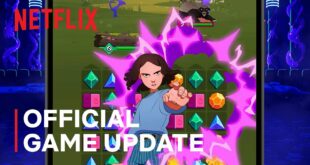Imagine what would happen if you took a half-season of The Walking Dead TV show, mashed it together with a Deus Ex or System Shock style of exploration and decision-making, and then drizzled it with the best aspects of a modern VR game. What you might end up with is a survival horror game that’s oppressively tense and brutal, but also tugs on you relentlessly to explore every corner of its post-apocalyptic world for hidden loot and nuggets of lore. The Walking Dead: Saints & Sinners is exactly that, and it absolutely nails the mix, delivering it with a level of detail and a depth of interactivity that feels like a genuine step forward for virtual reality.
You play as the Tourist, a storied survivor and living urban legend who seems to be immune to the fictional virus that makes everybody else a little bitier in The Walking Dead universe. You’ve rolled into the sunken remains of New Orleans following a rumor about a buried hotbed of limitless supplies called the Reserve, and the rest is up to you. It’s a simple setup, but one that’s perfect for the size and scope of Saints & Sinners because it doesn’t immediately saddle you with any presumptions about your character’s morality.
You’re introduced to New Orleans by your old buddy Henri, but the moral choices you’ll make while navigating its several open-ended zones are yours alone. As an Obsidian fan, I was pleased to find that there were several major factions fighting for control of the Reserve, each with their own perspective on the bleak situation around you. One such moral choice involves a mission where a faction member will send you to rescue their brother in exchange for an important item, and it’s fantastic that you can then choose to upend the original mission and kill the brother, earning his captors as allies and instead taking the item by force – if that’s the path you prefer, of course. Saints & Sinners’ ending depends entirely on the decisions you make throughout the campaign too, few of which are decidedly ‘good’ or ‘evil’.
All that choice makes the Tourist primarily a shell for you to insert your own personality into, with decent voice acting that gives life to each dialogue option, much like Commander Shepard in the Mass Effect series. By comparison, Telltale’s The Walking Dead accomplished some truly great feats of cinematic storytelling and meaningful decision-making in its hostile and zombie-riddled world, but it never gave me free rein to do whatever I wanted. That’s something I had craved for years when I was a regular watcher of The Walking Dead TV series, and while Telltale’s take on The Walking Dead certainly made me care about Clementine, it never made me feel like I was in that world.
“
Saints & Sinners scratches that itch with the grace and confidence of a well-lubricated bowie knife. The portrayal of killing zombies – or walkers – has never been as satisfying as it is here, and the abject terror of an unexpected walker swarm has never been as palpable. Zombie guts and brains are rendered with great detail, but what really grounds you in this world is the fact that weapons have appropriate weight and heft. Heavy weapons like axes and rifles require you to grip them with both hands for stability, while small weapons like shivs are much lighter and easier to land precise blows with. It’s not as nuanced as a game like Boneworks; you can’t wield just any item as a weapon, but this combat system is far more tactile and exciting than if you were doing it remotely with a gamepad or a keyboard.
Diseased walkers explode and unleash poisonous gases that lower your health pool when killed up close, meanwhile helmeted walkers are far tougher to kill, requiring a complete decapitation or extremely precise blows to exposed parts of their heads. This increased challenge only adds to the intensity of fighting an entire pack of walkers at once, a common occurrence later on, as you need to quickly pick and choose which walkers need to be killed in which way and in which order to preserve the durability of your best weapons. Rapidly juggling my inventory in real-time to acclimate to each fight forced me to be smarter and, as a result, Saints & Sinners never fell into that Action-RPG trap of becoming repetitive. I spent a little over 18 hours in the campaign – the story itself is a few hours shorter than that, but it was just loads of fun to complete scavenging runs and hunt for secret recipes on my own.
The walkers and human NPCs themselves have their own agendas too, often interacting with one another in interesting and useful ways. While the AI isn’t always the most bright, causing enemies to sometimes get stuck in hilarious and vulnerable positions, an impressive amount of the unfurling drama that makes Saints & Sinners exciting is simulated in real-time rather than deliberately scripted. To my satisfaction, I found that many of the quests allowed me to choose my own path to a solution, and it was a delight to discover alternate routes and secrets, even if the map can feel a little nondescript or claustrophobic at times. Even when I was presented with straightforward options for moving through a group of wary human NPCs or solving a quest with diplomacy – or simply by attacking an NPC directly – I could just as easily avoid interacting with certain characters altogether, either by attracting a herd of walkers and sneaking past the ensuing carnage, or by climbing over the side of a wall or up the side of a house. That freedom to tackle a situation so many different ways is fantastic.
And though the bigger story about breaking into the Reserve can sometimes feel pretty thin between long periods of exploring, looting, killing, and crafting my way through the streets of New Orleans, it was refreshing for a VR game to let me define my character through my own decisions in a setting as meticulously detailed and open-ended as this. While Saints & Sinners isn’t exactly the first of its kind, this caliber of storytelling reaches a height that VR had otherwise yet to achieve.
Zombalaya
Central to the tension of Saints & Sinners is that you only get so much time each day to do things before the city’s bells are rung and the streets flood with ravenous corpses. Once you head back to safety you can go to sleep and skip to the next morning, but the number of undead you encounter the following day increases. This creates a compelling risk-reward choice between pushing your luck past dark or playing it safe at the cost of worse odds tomorrow, driving the tension of the entire game.
That dilemma would be perfectly manageable if not for the fact that you only have a limited amount of inventory space, pushing you to think more carefully about what you grab. You also have to continue crafting or finding new weapons as your old ones tend to fall apart at a distressingly high rate. That forces you to make each attack count, which is easier said than done since you actually have to swing and aim with your real-world appendages. With a ticking clock looming behind all that, Saints & Sinners quickly becomes the perfect storm for adrenaline junkies.
Luckily, the inventory management is intuitive and feels great. Picking up items and placing them into your backpack is as simple as throwing them over your shoulder, and to access them again you simply grab the pack off of your back and pull items out of their neatly arranged slots. Meanwhile, weapons can be holstered in convenient slots on your waist and back while your journal and flashlight fit snugly on your chest. This style of physical inventory management has existed in VR games like Rec Room and Township Tale for some time, and it’s far more interactive and interesting than simply tapping on a menu screen with your fingers or pointing at some text with a laser pointer.
“
Limited stamina is also a worry. Running out of stamina makes you slow and unable to swing, aim, or run away, meaning it’s all the more critical to land each and every blow with finesse. Likewise, having a strong weapon or beefed up stamina pool makes you feel satisfyingly powerful, but never so much that you can let your guard down, keeping combat engaging even as you get stronger.
If you do die to the shambling hordes, you’re forced to respawn at the start of the map while the day’s clock is still ticking, and you only get one chance to reclaim your inventory before it’s gone forever. As time wears on, high-quality supplies and weapons can become so difficult to find that scrounging up a broken bottleneck or screwdriver in the nick of time is sometimes the difference between life and death. This, mixed with the fact that your health and stamina pools are temporarily decreased when you die, is a perfect formula for some of the most terrifying moments I’ve had in a VR headset – but that terror was met with an equal amount of satisfaction if I could make it back to my loot and come out alive after.
It is disappointing that character progression is fairly linear, with only a few tech trees to branch into – Gear, Guns, and Survival – and no mutual exclusivity between them. There’s nothing stopping you from unlocking every possible upgrade at the crafting stations in short order, just as long as you can find the right components from scrapping items you find in the world, similar to Fallout 4. It’s plenty of fun to use newfound upgrades like the Nail Bomb and the Grass Cutter, and there are some recipes that you first have to uncover the hidden nooks and crannies of New Orleans to find, but it’s too bad that there’s no real way to personalize your Tourist beyond the story choices you make.
Source link
More Gaming Stories
 Epic Heroes Entertainment Movies Toys TV Video Games News Art Pop culture news goodness
Epic Heroes Entertainment Movies Toys TV Video Games News Art Pop culture news goodness




